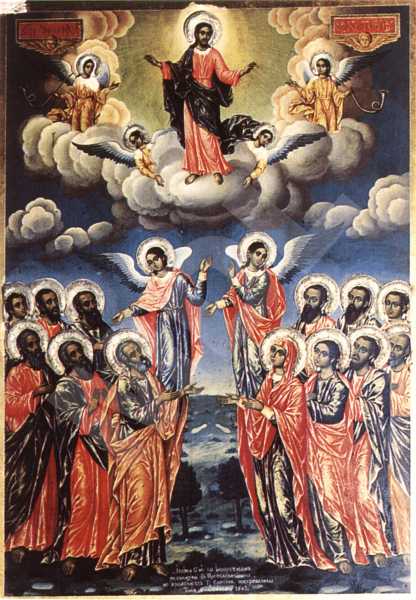The Ascension of Christ
Type:
Icon
Period:
From
to
1843 year
Dimiter T. Molerov, born in 1780 in Bansko, son of Toma Vishanov the Moler. One of the best-known painters, a representative of the Bansko school of art, a disciple of his father, influenced by the art of Athos. Author of the murals of the naos in the St Archangels' paraclete in the Rila monastery, the murals in the Church of the Assumption of the Virgin in the Pchelino dependance. In 1840 and 1841 together with his son Simeon Molerov he paints the murals and the sponsors' portraits in St. Nicholas' and St. John of Rila's paracletes in the principal church in the Rila monastery. Among D. Molerov's major achievements in iconography are the following icons: St. Nicholas (1816) from St. Archangel Michael's church in the village of Leshko, Christ All-triumphant with Angels and Cherubim (1833), The Nativity and a Crucifixion from St Elijah the Prophet's church in the village of Usenovo. He has also worked in Belgrade on an invitation by Prince Milosh Obrenovich of Serbia. He died in 1870 in Bansko.
Dimmensions (cm):
98
/ 75
/ 2.5
Location
Country: Bulgaria
Province: Blagoevgrad
Monastery: Rila Monastery
Church: The Nativity of the Virgin
Other location: In the southern ark in the naos
Source
Country: Bulgaria
Province: Blagoevgrad
Monastery: Rila monastery
Church: The Nativity of the Virgin
Description
A traditional iconographic composition on this theme, with a rich modelling of the garments and the faces of the figures. A rich interplay of colours.
Iconographical technique: Tempera
With velaturas, probaster and a rich gilding on the garments of the disciples, of the angels and of Christ.
Base material: Wood
The icon's base is of two softwood panels, joined by means of two inserted beams. The ground coat is of plaster, laid thinly and well-smoothed.
State, restoration traces and comments
There are silver repousse covers, very precisely engraved, over the nimbi of all the figures.
There are no traces of any previous restorative intervention. The icon carries a donor's inscription.


